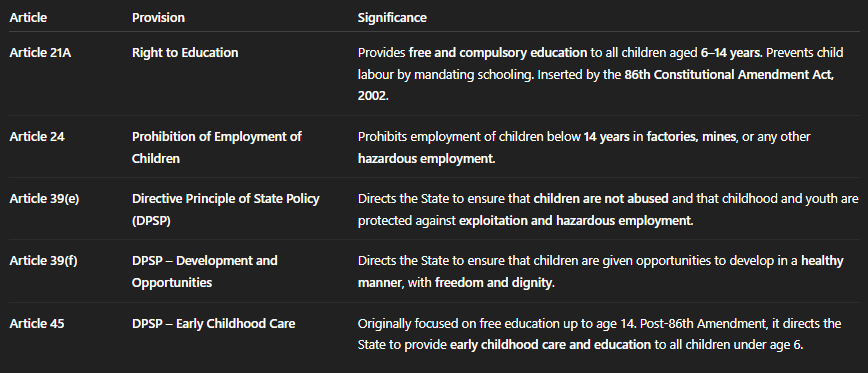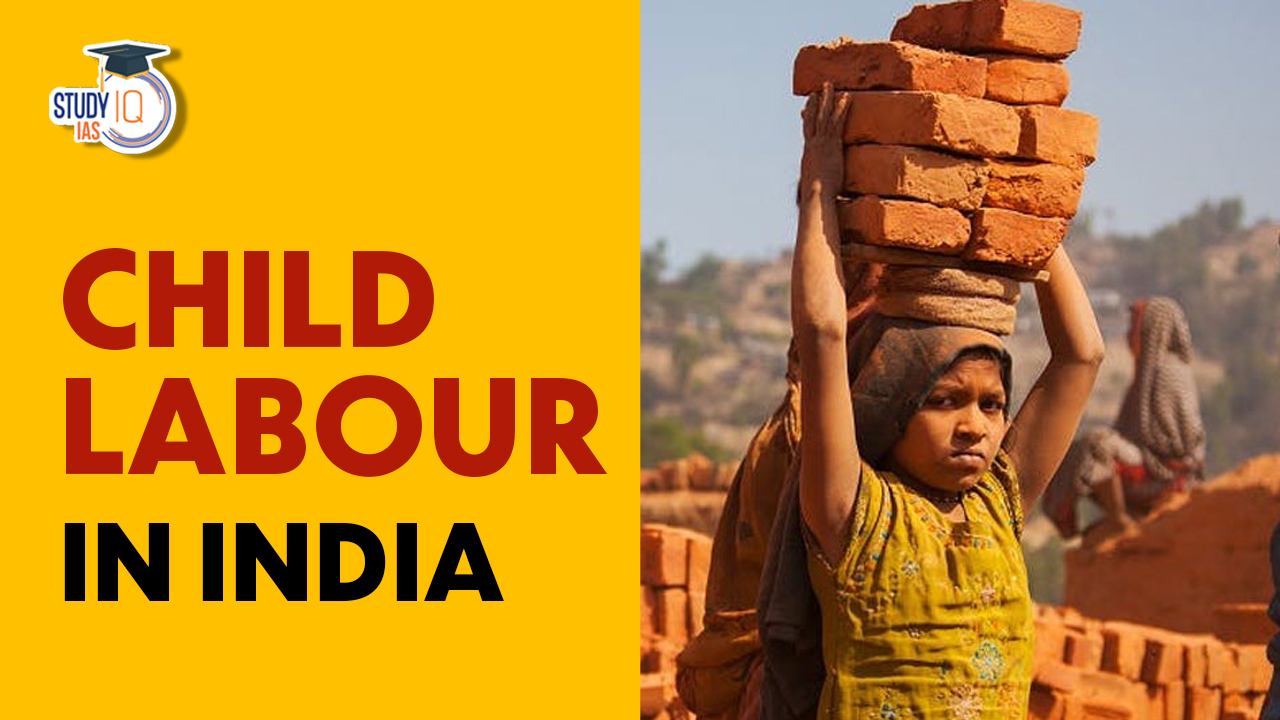Table of Contents
Context: Recently, Just Rights for Children (JRC), in collaboration with NGOs and law enforcement, published observations related to child labour prevalence in India.
Every year, June 12 is observed as World Day Against Child Labour under the aegis of the International Labour Organisation (ILO). It serves to raise awareness and mobilise action to eliminate child labour globally. Despite various efforts, the issue remains deeply entrenched, particularly in developing countries. Read this article to know all about the status of Child Labour in India, its Causes, related Challenges and Government Initiatives To Eradicate Child Labour in India.
Child Labour in India
In India, child labour refers to activities that are damaging to kids in terms of their mental, physical, social, or moral development; they rob them of their youth, potential, and dignity; and interfere with their schooling. It includes all types of slavery, including the sale and trafficking of children, servitude for restitution, forced labour, the enlistment of children in military combat, the employment of children in pornographic or other dangerous work, and debt bondage.
Key Findings of Child Labour in India Published by Just Rights for Children (JRC)
Child Labour Rescues in India (April 2024–March 2025)
- Total rescues: 53,651 children across 24 states/UTs.
- Top 5 states by rescues:
- Telangana – 11,063
- Bihar – 3,974
- Rajasthan – 3,847
- Uttar Pradesh – 3,804
- Delhi – 2,588
Trends in Exploitation
90% of rescued children (mainly aged 10–14) were in the worst forms of child labour:
- Spas, massage parlours, orchestra troupes, and domestic work
- High risk of sexual exploitation, pornography, and prostitution.
- Sexual exploitation rescues: 2,971 children; top states—West Bengal (1,005), Bihar (454), Odisha (232), Maharashtra (194), Rajasthan (191).
Enforcement & Legal Action
- Rescue operations: 38,889 conducted by NGOs in collaboration with law enforcement.
- FIRs & arrests:
- 38,388 FIRs
- 5,809 arrests made, 85% related to child labour.
- Telangana led in both rescues and arrests, followed by Bihar and Rajasthan.
- Notable enforcement gaps: UP and MP had many rescues but fewer arrests.
Status of Child Labour in India
- As per Census 2011, 53 lakh (4.35 million) children in the 5–14 age group were involved in child labour.
- India’s child labour is concentrated in:
- Beedi-making (tobacco),
- Carpet weaving,
- Firework industries (notably in Tamil Nadu),
- Agriculture and domestic work in both rural and urban areas.
- The COVID-19 pandemic reversed some progress, as many children dropped out of school due to economic pressure and did not return.
|
Child Labour in India: Overview |
|
| Particulars | Details |
| Constitutional Provision |
|
| Legal Provision |
|
| Census 2011 |
|
| Census 2001 – 2011 |
|
| Percentage of child labour in India |
|
| States with max child laborers |
|
| ILO – Worst Forms of Child Labour (Convention No. 182) |
|
| SDG 8.7 |
|
| National Child Labour Project (NCLP) Scheme |
|
| Body for the Protection of Child Rights |
|
Causes of Child Labour in India
Different causes of child labour in India have been mentioned below:
- The frequency and expansion of child labour are significantly influenced by the rising demand for it, especially in urban areas. Due to their low cost and ability to adapt to the needs of the employer, children are frequently hired, even if they are not aware of their legal rights.
- Prevalence of Poverty and the Debt Trap in India, especially in rural India
- Poverty is the primary driver of child labour. A child’s income is frequently crucial to his or her life or the life of the family in impoverished households. Children frequently have to work because the family is in debt.
- Due to rural poverty and urban migration, child trafficking for labour is a common occurrence.
- Adult unemployment and underemployment: Because these conditions are so common, children are regularly required to work to support their families.
- Parental illiteracy and ignorance: The issue is exacerbated by the child’s parents’ lack of education. They flout the law and subject their children to cruel exploitation because they lack literacy and knowledge of the negative effects of child labour.
Challenges Associated with Child Labour in India
| Challenge | Explanation & Example |
| Poverty | Families see child labour as an economic necessity. E.g., agricultural labour in UP & Bihar, stone factories in Rajasthan, etc. |
| Lack of Access to Quality Education | Inadequate infrastructure and high dropout rates. Many children, especially girls, do not complete schooling. |
| Weak Enforcement of Laws | Despite legal frameworks like the Child Labour (Prohibition and Regulation) Act, 1986, enforcement is often lax. E.g., Firecracker units in Sivakasi (Tamil Nadu) have repeatedly faced scrutiny but continue employing minors. |
| Informal Economy and Hidden Labour | Many child labourers are “invisible” as they work in homes, fields, or family-run businesses. |
| Cultural Acceptance and Social Norms | Child labour is normalized in some communities where children are expected to support the family from a young age. |
| Intergenerational Debt and Bonded Labour | Many children are forced to work to repay family debts. This is seen in brick kilns and quarries. |
Global Target for Eradication of Child Labour
The Sustainable Development Goal (SDG) Target 8.7 aims to: “Take immediate and effective measures to eradicate forced labour, end modern slavery and human trafficking, and secure the prohibition and elimination of the worst forms of child labour, including recruitment and use of child soldiers, and by 2025 end child labour in all its forms.”
Government Initiatives To Eradicate Child Labour in India
The Government of India have been taking several initiatives for eradicating child labour in India, as mentioned below:
Constitutional Provision
- The Constitution (Eighty-sixth Amendment) Act of 2002 added Article 21-A to the Indian Constitution, establishing it as a Fundamental Right to provide all children between the ages of six and fourteen with free and compulsory education by any legal requirements imposed by the State.
- Article 23: Prohibits forced work and human trafficking.
- Article 24 states that no child under the age of fourteen may be employed in a factory, mine, or in any other dangerous occupation.

Legislative Measures
Child Labour (Prohibition and Regulation) Act, 1986 (Amended in 2016)
- Prohibits employment of children below 14 years in all occupations.
- Prohibits adolescents (14–18 years) from working in hazardous occupations/processes.
- Introduced stricter punishment:
- Employers: ₹20,000–₹50,000 fine and/or imprisonment up to 2 years.
- Parents: Exempt from punishment unless they repeatedly force child labour.
Right of Children to Free and Compulsory Education Act, 2009
- Guarantees free and compulsory education to every child aged 6 to 14 years.
- Encourages school enrolment and reduces dropout that leads to child labour.
Juvenile Justice (Care and Protection of Children) Act, 2015
- Treats child labour as a form of abuse and neglect.
- Allows stricter legal action against violators under child protection mechanisms.
Government Schemes To Eradicate Child Labour in India
- National Child Labour Project (NCLP) Scheme
- Launched in 1988.
- Provides non-formal education, vocational training, stipends, nutrition, and healthcare to rescued child labourers.
- Operates rehabilitation centres in child-labour-prone districts.
- Samagra Shiksha Abhiyan: Focus on inclusive education for out-of-school and working children.
- Mid-Day Meal Scheme: Incentivises school attendance by providing free cooked meals to children.
- Reduces the economic burden on poor families.
- Skill India: Trains youth (14–18 yrs) for formal sector jobs, reducing unsafe work.
Awareness Campaigns
- “PENCIL Portal” (launched 2017): Platform for Effective Enforcement for No Child Labour.
- Integrates data, complaint management, and rescue operations.
- Childline 1098: A 24×7 helpline to report child labour or abuse cases.
- Social Media Campaigns & School Drives: Regular campaigns during World Day Against Child Labour (June 12) and Child Rights Week.
Policy Recommendations
- National Mission to End Child Labour with dedicated funding.
- District-level Child Labour Task Forces.
- Child Labour Rehabilitation Fund and National Rehabilitation Policy.
- Make education compulsory up to 18 years.
- Implement a zero-tolerance policy on child labour in government procurement.
- Expand the list of hazardous occupations under law.
- Extend SDG 8.7 target deadline to 2030
Way Forward
| Measure | Details |
| Strengthen Enforcement | Stricter implementation of laws like the CLPRA (Amendment Act), 2016, which bans child labour under 14. |
| Universal Access to Quality Education | Ensure effective implementation of the Right to Education (RTE) Act, 2009, with a focus on retention. |
| Social Protection for Vulnerable Families | Expand coverage of welfare schemes like PM-KISAN, MGNREGA, and mid-day meals to reduce reliance on child income. |
| Awareness Campaigns | Change societal attitudes towards child labour through mass campaigns involving media, schools, and communities. |
| Skill Development and Adolescent Support | For children aged 14–18, provide vocational training and safe work alternatives. |
| Community Mobilization | Local ownership and monitoring, as seen in the Velpur Model, should be encouraged across India. |
Velpur Model – A Community-led Success Story
- Location: Velpur Mandal, Nizamabad District, Telangana (then Andhra Pradesh)
Key Features
- In 2001, a 100-day community-driven campaign was launched to send all children (5–15 years) to school and eliminate child labour.
- Initial Resistance: Misinformation and hostility from the public.
- Transformation: With sustained engagement, the community embraced the movement.
- Outcomes:
- Velpur was declared child-labour free on October 2, 2001.
- Employers wrote off debts worth ₹35 lakh, freeing children from bonded labour.
- Every sarpanch signed an MoU with the district administration to ensure school enrolment.
- Local boards declared: “There is no child labour in our village.”
- Recognition from ILO, VV Giri National Labour Institute, and former President APJ Abdul Kalam.
- A rare example of sustained success for over two decades.
Takeaway: Velpur’s success shows that social reform is sustainable only when it becomes a people’s movement, backed by local leadership and supported by state capacity.
The fight against child labour is not just a legal or policy challenge—it is a moral imperative. While India has taken steps forward, the Velpur model proves that the real change begins at the grassroots, with communities taking charge of their children’s futures. Scaling such models with government support, legal enforcement, and civil society participation can help India meet the SDG 8.7 target and ensure every child gets a fair start in life.


 Custodial Deaths in India, Types, Issues...
Custodial Deaths in India, Types, Issues...
 Maternal Care in India, Challenges and G...
Maternal Care in India, Challenges and G...
 Maternity Benefit Act 1961, Applicabilit...
Maternity Benefit Act 1961, Applicabilit...





















